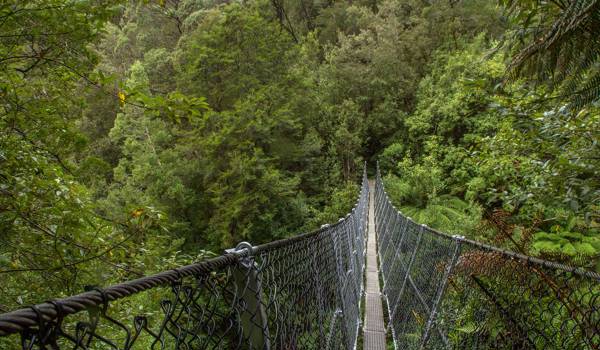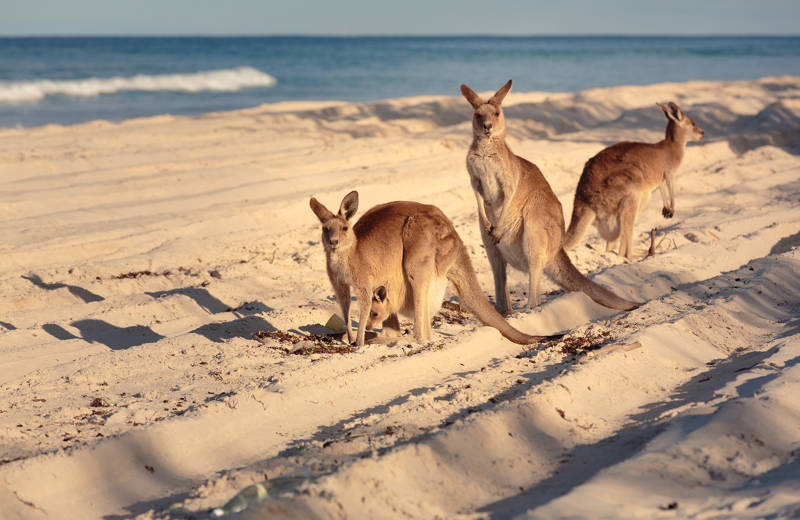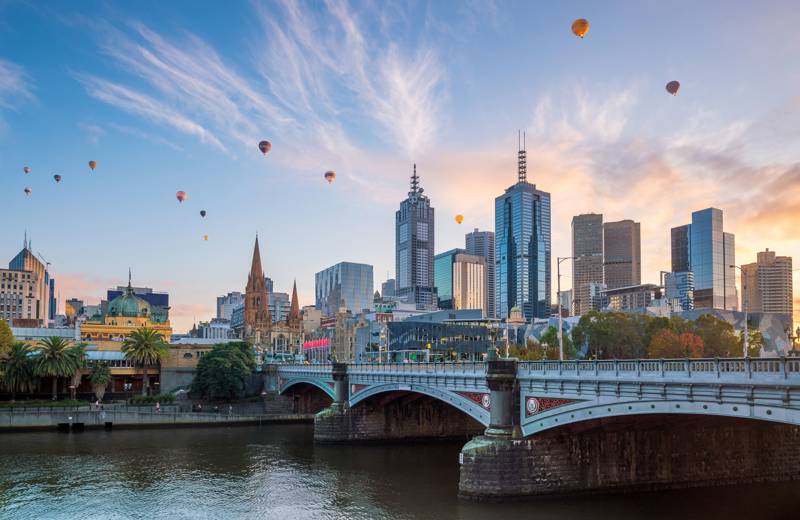When to Go to Australia: A Seasonal Guide
To make the most of Australia’s beaches, wildlife, and cultural events, the right timing is key. This no-fluff guide delivers the sharpest insights on the best time to visit Australia, walking you through each state’s high points from the sun-soaked coasts to the big cities. Navigate Australia’s seasons with us and land on the perfect dates for your big trip down under.

When to travel to Australia (in short)
In our guide below we'll take a deep dive into all the aspects of what would be the perfect time to fly to Australia for your trip, there are the key points to remember.
-
The best time to visit Australia depends on your activities and destinations, with the south having distinct seasons and the north being tropical year-round with temperatures in winter (June to August) averaging around 22 degrees in Cairns.
-
For beachgoers, hit the Gold Coast between April and June, the Great Barrier Reef from May to October, and be mindful of stinger season in tropical regions, which on the east coast runs from November to May.

Seasonal overview of Australia
Australia’s climate is as diverse as its landscapes. From the tropical north to the moderate south, the best time to visit Australia really depends on your itinerary. The southern half of the country, including New South Wales, Victoria, and South Australia, experiences four distinct seasons. Summer spans from December to February, perfect for beach activities under the hot sun. Autumn arrives from March to May, painting the cities with vibrant colors and bringing cooler days, ideal for city festivals and wine tours in the southern wine regions.
In contrast, the seasons in Australia are as follows, showcasing its temperate climate:
-
Summer: December to February, with hot and humid weather
-
Autumn: March to May, with mild temperatures and colorful foliage
-
Australian winter: June to August, with cool temperatures and dry weather
-
Spring: September to November, with warm and sunny days and cooler nights
If you’re heading up to northern Australia, expect increased rainfall during the summer rainy season and spring, but don’t let that knock down your spirit - it’s the season when young koalas and kangaroos say hello to the world, making for a great wildlife spotting experience.

Beach Destinations: When to Visit for Sun and Surf
Australia is synonymous with stunning beaches, boasting a coastline that stretches over 30,000 kilometers. But when should you slap on the sunscreen and hit the waves? Well, if you’re heading to the Gold Coast of Queensland, April to June is your best bet. During these months, the water temperatures are warm, making it ideal for a dip or a surf.
However, if your journey takes you to the tropical north, including the Great Barrier Reef, target the dry season from May to October. The weather is perfect for beach visits without the threat of stingers. But be warned, from November to May, stinger season affects northern tropical regions like Darwin and Cairns, so you’ll need protective suits for reef activities.
Considering Western Australia? Here are some reasons why you should visit:
-
Autumn introduces cooler weather, ideal for beach visits
-
Summer offers prime conditions for beach activities and wildlife encounters
Wildlife Watching Opportunities in Australia
If you’re an animal lover, Australia is your paradise. With unique wildlife watching opportunities throughout the year, there’s never a dull moment. From May to November, the oceans become a ballet performance of southern right whales, humpback whales, and dwarf minke whales. These majestic creatures can be seen in places like Victorian waters, Hervey Bay, and the Great Barrier Reef.
However, the wildlife display is far from over. Here are some incredible experiences you can have in Australia:
-
The annual crab migration on Christmas Island
-
Snorkeling among whale sharks at Ningaloo Reef from March to July
-
Observing turtle nesting on the east coast with hatchlings emerging between January and March
These experiences will leave even the most seasoned nature lovers in awe.
And let’s not forget birdwatching at Kakadu National Park’s Mamukala Billabong in spring or spotting kangaroos and echidnas in the Northern Territory during the dry season. The wildlife in Australia really is as diverse as its landscapes!

Exploring Australia's National Parks
Australia’s national parks are a testament to the country’s natural beauty and biodiversity. When, though, is the prime time to discover these national gems? Kakadu National Park, for instance, is best visited during the cooler months of May to August. But if you’re after the lush, green landscape in Kakadu, March or April, right after the wet season, is your best bet.
The Daintree National park in the tropical North Queensland area is a primeval paradise, boasting some of the oldest rainforests on the planet. With lush canopies, remarkable biodiversity, and the enchanting beauty of the ancient flora and fauna, it's a living museum of natural history. To fully appreciate the wonders of Daintree, the best time to visit is during the dry season, from June to October. During these months, the rainfall is minimal, allowing for clearer paths and easier access to the park's many attractions, such as the Mossman Gorge, Cape Tribulation, and the Daintree River. It's also the perfect time for birdwatching, as many species are more active and visible. Plus, the reduced humidity makes for a more comfortable trek through the dense rainforest. So pack your hiking boots and prepare for an adventure into the heart of nature's own heritage site.
Conversely, the Blue Mountains National Park is at its best during spring, providing mild weather and blue skies perfect for outdoor exploration in the northern hemisphere. If stargazing is on your bucket list, the cooler winter months in central Australia provide clear views of the outback sky. So, whether you’re a bird watcher, a star gazer, or a nature lover, Australia’s national parks have something for everyone, all year round.

Regional Breakdown: Best Time to Visit Each State and Territory
Planning for a city break or an all-out Aussie road trip? Here’s a detailed breakdown of the optimal time to visit each state and territory. For southern Australia and the cities of Melbourne and Sydney, aim for the shoulder seasons from March to May and September to November. These months offer pleasant temperatures and relatively fewer tourists. As for Brisbane, its subtropical climate makes it an enjoyable destination any time of the year.
The Top End of Australia, including the Northern Territory and parts of Western Australia and Queensland, is best visited between May and September. This coincides with the dry season when the weather is most pleasant. Keep in mind, Australia is a vast continent and each region boasts its unique charm and climate. Let’s delve further and dissect the prime times for visiting each state and territory.
Queensland
Queensland, known as Australia’s Sunshine State, is a tropical paradise. If you’re planning a visit, the Australian autumn, particularly from March to May, is the most mild and pleasant. During these months, you can enjoy the subtropical and tropical climates of the region at their best.
For an even more comfortable experience, aim for May to October when Far North Queensland boasts average temperatures ranging between 25 and 30 degrees Celsius. This period is perfect for exploring the northern parts including the enchanting Whitsunday Islands, which become a hotspot for sailing, snorkeling, and beach activities in springtime.
New South Wales
New South Wales, home to Sydney, offers a mix of bustling city life and breathtaking natural beauty. The shoulder seasons between spring and autumn are considered the best times to visit. During these times, the weather is warm and pleasant, making it ideal for exploring the city and the surrounding regions.
Spring in New South Wales is a special treat for wine lovers, with the Hunter Valley hosting a wine and food festival that takes advantage of the region’s fresh produce, breathtaking scenery, and gourmet experiences. Whether you’re a wine connoisseur or a nature lover, New South Wales has something for everyone.
Victoria
Victoria, home to Melbourne, is known for its cultural diversity and sporting events. Late summer, specifically March and April, is the best time to visit. The reasons are:
-
The weather is usually pleasant
-
The scenery is beautiful during this period
-
During these months, the weather is warm
-
There are fewer tourists compared to the peak summer months
Spring in Victoria is also a sight to behold, with blooming flowers and full waterfalls creating scenic landscapes. Whether you’re visiting the Mornington Peninsula or the Yarra Valley, spring is an ideal time for exploration.
Tasmania
Tasmania may be small, but it’s packed with natural beauty and cultural richness. It offers a quieter alternative to the Australian mainland, attracting fewer tourists while providing pristine attractions. The best time to visit is spring, particularly if you’re a food lover. The island offers a 10-day food and wine adventure that takes advantage of fresh produce, breathtaking scenery, and gourmet experiences.
Spring in Tasmania is also marked by events such as the Tasmanian Craft Fair and the Bicheno Food and Wine Festival. These events celebrate local produce and artisanal goods, making it an excellent time for culinary exploration.
Western Australia
Western Australia is a land of contrasts, featuring diverse climates and landscapes. The best time to visit Perth and the southern regions is from November to February, during the summer months. The region experiences long, hot summers and mild, cool winters.
In contrast, the northern parts of Western Australia are best visited from June to August. These cooler months offer drier weather in the north and more affordable international flights. So, whether you’re planning a city break in Perth or an outback adventure in the north, Western Australia offers a unique Aussie experience.
Northern Territory
The Northern Territory, often referred to as Australia’s ‘Outback’ and part of the vast region of northern Australia, is a land of red desert, stunning gorges, and rich Aboriginal culture. The best time to visit is during the dry season from May to October. During these months, the Red Centre, including Alice Springs and Uluru, is at its coolest.
Visiting during the shoulder seasons, such as April for the Red Centre and April to May for the Top End, is also advisable. These months offer clear skies, lush landscapes, and fewer tourists, making for a more comfortable and enjoyable experience.

Tips for Avoiding the Crowds and Saving Money in Australia
Given its popularity, Australia can become crowded, particularly during the summer and school holiday periods. To avoid the crowds, consider visiting in the quieter months such as winter or during the shoulder seasons of spring and fall. Not only will you avoid the crowds, but you’ll also experience a different side of Australia.
In terms of saving money, thoughtful planning can yield significant benefits. Here are some tips:
-
Avoid peak times and book accommodations early to get the best deals.
-
If you’re flexible, last-minute deals can also offer significant savings.
-
Don’t forget to explore off the beaten track locations. These lesser-known spots not only offer a unique experience but also allow for a less crowded and potentially cheaper Aussie adventure.
Outdoor Adventure Activities in Australia
As an adventurer’s dreamland, Australia offers an abundance of outdoor activities all year round. For surfers, the winter months from June to August offer increased swell quality across all major surfing regions. However, for those still learning to ride the waves, the warm summer months of December through February offer smaller swells but still provide adequate surfing conditions.
Winter sports enthusiasts can head to Victoria’s alpine regions and the Australian Alps in New South Wales or Victoria for skiing and snowboarding. On the other hand, if sailing is your passion, don’t miss the annual Hamilton Island Race Week in August and the Rolex Sydney Hobart Yacht Race in December.
Runners can also enjoy major marathons like the Gold Coast Marathon and the Sun Herald City2Surf in Sydney. These events showcase scenic routes and attract runners from all over the world. So whether you’re a surfer, skier, sailor, or runner, Australia has an outdoor adventure waiting for you.

Frequently asked questions
The most frequently asked questions regarding the best time to travel to Australia.
What is the best month to travel to Australia?
The best months to travel to Australia are usually September to November, and March to May. These shoulder seasons offer good weather, fewer crowds, and reasonable accommodation prices.
What are the three hottest months in Australia?
The three hottest months in Australia are December, January, and February, making it a great time to head south to escape the heat or if you like the tropics - explore the northern regions like North Queensland and the Darwin area.
Is Australia expensive to visit?
Yes, Australia is generally expensive to visit, but by opting for hostels or cheaper campsites (if you've got a campervan) you can keep the price down. It can be worth it to calculate your options and see whether campervans (you save on accommodation) vs. a bus pass (you save on transport) are more favourable for your route. Our travel experts will gladly help you with that!
When is rainy season in Australia?
The rainy season in Australia is between November and April, with spectacular thunderstorms and high humidity, reaching up to 98%. So, if you plan to visit during this time, be prepared for intense rainfall and high temperatures.
When is the best time for wildlife watching in Australia?
The best time for wildlife watching in Australia varies depending on what you're interested in. For whale watching, go from May to November; for snorkeling with whale sharks, go from March to July; and if you want to observe turtle nesting, the best time is between January and March.

